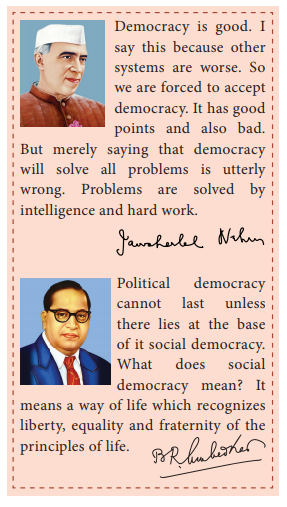Chapter: 11th Political Science : Chapter 5 : Democracy
Achievements of Indian Democracy
Achievements of Indian Democracy
The founding fathers of India and its Constitution
had built strong democratic foundations in the Indian State and the
Constitution thus making India a great country. The democratic constitutional
foundations have strengthened the Constitution in every aspect of
socio-political and economic changes. The Preamble of the Constitution laid
down clear road map with Fundamental Rights and Duties, Directive Principles;
Parliamentary System and Amendment Procedures; Judicial Review and Basic
Structure doctrine.
Political front
·
During the first general election
in the 1951 India had 54 political parties and now it has grown up to 464 in
the 2014 general election as an evident of deepening of the democratic process.
·
In the first General election
1951, 173 million citizens were given right to vote; of these, 44.87 percent
exercised their franchise. In the 16thgeneral election in 2014, the size of the
electorate had increased to 814 million the voting percentage had gone up to
66.4 and of these, 67.9 percent were men and 65.6 percent women. The number of
contestants was increased to 8,251.
· Since
2004, votes are recorded through (EVMs) electronic voting machines. These are
manufactured in India and their accuracy is ensured and secrecy has been fully
tested.
· Our
electoral system known as FPTP or ![]() First-Past-The-Post
system, is a single-member district, simple -plurality system in which voters
cast a single ballot to choose a single representative to the lower house of
parliament or the State legislative assembly, the candidate with largest number
of votes, even if only a plurality, getting elected to represent the
constituency.
First-Past-The-Post
system, is a single-member district, simple -plurality system in which voters
cast a single ballot to choose a single representative to the lower house of
parliament or the State legislative assembly, the candidate with largest number
of votes, even if only a plurality, getting elected to represent the
constituency.
· Since
1989, the citizens were given a chance to elect their representatives at the
age of 18, this is another feather in the crown of democracy.
· India is
the world’s the largest democracy proved success in accommodation of group and
regional demands in a complex, quasi-federal, polity.
·
The 73rd and 74th amendment of
the constitution has given the reservation for SC/STs, women in the Local
self-governing bodies like panchayats, municipalities and corporations as
members, councillors and mayors.
India’s democratic set up has been vibrant and able
to keep the military out of political power. It also shows prudence on the part
of military generals and defence personnel earning respect from the executive.
Social Front: The democratic
process has brought about a shift of political
power from the middle and higher castes and classes of urban society to
backward classes who are now the politically most influential ones in the
country. They have won reservations for themselves in legislatures and
government services as were accorded to the Scheduled Castes and Scheduled
Tribes after independence through Constitutional provisions.
India’s institutions like the free press and an
independent judiciary have ensured that India remains a society based on rule
of law.
The life expectancy at birth has almost doubled
from 36 years in 1951 to 66 years in 2011 due to the availability of better
health facilities and the health programmes consistently implemented for the
well-being of the people to get away from the epidemics, endemics, communicable
and non-communicable diseases.
Similarly, diseases like smallpox and polio have
been eradicated. In education, the number of universities and colleges has gone
up from a minuscule 27 universities and 578 colleges in 1950-51 to an estimated
712 universities and 36,671 colleges in 2014. Similarly, literacy rates have almost
quadrupled from 18.3 percent of the population in 1951 to 73 percent in 2011.

Economic Front:
These include strategic affairs and security,
politico-legal democratic governance as well as society and economy.
·
India has been able to emerge as
a regional power in Asia and super power in south Asia backed by its economic,
military and nuclear capabilities.
·
It meant centralized planning
till 2017 and a very big public sector for industries catering employment and
science and technology education for the youth in the country, but soon there
were inefficiencies and labour issues it resulted in a move towards a more open
liberalized and market driven model of the economy starting in the 1991 reforms
called as Structural Adjustment Programme. Post this, the economy has seen
greater private and foreign participation found the base for the emergence of
professional new middle class. The technological innovations applied in
transforming the service sector particularly Education, Health and
transportation along with rural and urban infrastructure lead to digital India
and reforms in banking sectors has brought a great social transformation in
reality.
·
India’s Gross National Income
(GNI) at constant prices has increased more than 35 times from Rs. 2.92 lakh
crore in 1950-51 to Rs. 105.28 lakh crore 2014-15. Similarly, the per capital
income at current prices has risen from a poultry Rs. 274 In
1950-51 to a decent Rs. 88,533 in 2014-15.
·
Food grain production grew from 50.8
million tonnes in 1950-51 to an estimated 264.77 million tonnes in 2014-15 that
indicates more than a five-fold increase and the fact that India is food secure
for the time being. It was made possible with rapid advances in agricultural
technology.
Related Topics